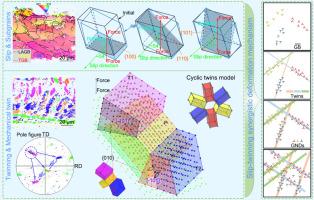原位拉伸试验中Cu/SAC305/Cu微焊点滑移孪晶协同变形机制
IF 14.3
1区 材料科学
Q1 MATERIALS SCIENCE, MULTIDISCIPLINARY
引用次数: 0
摘要
系统研究了Cu/SAC305/Cu微焊点在原位拉伸试验中的滑移孪晶协同变形机理。接头的极限抗拉强度为91 ~ 97 MPa,断口以韧窝带和脆性金属间化合物(IMCs)晶粒断裂为特征,呈现出与Sn晶粒取向密切相关的韧脆混合断裂模式。拉伸过程中亚晶和机械孪晶的形成表明,塑性变形是由位错滑移和孪晶同时激活控制的。亚晶的形成源于位错沿主要的{100}<;001>;、{110}<001>;和{101}<;111>;/2滑移体系滑动,以及锡晶格受钎料/Cu界面约束的旋转。同时,在{101}<;101>;孪晶体系中,力学孪晶通过原子沿[−101]方向的形变发生。具体来说,四分之一的原子沿着滑移方向显示,而其他三个原子重新排列以占据新的晶格位置,随后的晶体层移动以支持机械孪晶形成。一般来说,在拉伸条件下,几何上必需的位错首先在晶界附近产生,逐渐在亚晶界积累,并储存在晶粒内,最终激活孪晶,在随后的位错堵塞中形成机械孪晶。结果表明,小|∆λ|的Sn晶粒在拉伸过程中倾向于通过滑移形成亚晶,而大|∆λ|的Sn晶粒在拉伸过程中倾向于通过孪晶形成孪晶。由此建立了滑移-孪晶协同变形机制,突出了滑移和孪晶在拉伸条件下焊接点塑性变形过程中对亚晶和孪晶形成的协同作用。本文章由计算机程序翻译,如有差异,请以英文原文为准。

Slip-twinning synergistic deformation mechanism in Cu/SAC305/Cu micro solder joints during in-situ tensile test
The slip-twinning synergistic deformation mechanism in Cu/SAC305/Cu micro solder joints during in-situ tensile test was systematically studied. The joints exhibited an ultimate tensile strength of 91–97 MPa, with fracture surfaces characterized by dimpled zones and fractured brittle intermetallic compounds (IMCs) grains, revealing a ductile-brittle mixed fracture mode strongly correlated with Sn grain orientation. The formation of subgrains and mechanical twins during tensile indicated that the plastic deformation was governed by the concurrent activation of dislocation slip and twinning. Subgrains formation originated from dislocations slipping along the dominant {100}<001>, {110}<001>, and {101}<111>/2 slip systems, as well as the rotation of Sn lattices constrained by the solder/Cu interfaces. Meanwhile, mechanical twins occurred via atomic deformation along the [−101] direction in the {101}<101> twin system. Specifically, one out of four atoms displayed along the slip direction, while the other three atoms rearranged to occupy new lattice positions, with subsequent crystal layers shifting to support mechanical twins formation. In general, under tensile conditions, geometrically necessary dislocations initially generated near grain boundaries, progressively accumulated at subgrain boundaries, and stored within grains, ultimately activated twinning to form mechanical twins upon subsequent dislocation blockage. And the results pointed out that Sn grain with small |∆λ| preferred to form subgrains by slip, while Sn grain with large |∆λ| would generate twin grains by twinning during tensile. Thus, a slip-twinning synergistic deformation mechanism was established, highlighting the synergistic effect of slip and twinning on the formation of subgrains and twins during the plastic deformation of solder joints under tensile conditions.
求助全文
通过发布文献求助,成功后即可免费获取论文全文。
去求助
来源期刊

Journal of Materials Science & Technology
工程技术-材料科学:综合
CiteScore
20.00
自引率
11.00%
发文量
995
审稿时长
13 days
期刊介绍:
Journal of Materials Science & Technology strives to promote global collaboration in the field of materials science and technology. It primarily publishes original research papers, invited review articles, letters, research notes, and summaries of scientific achievements. The journal covers a wide range of materials science and technology topics, including metallic materials, inorganic nonmetallic materials, and composite materials.
 求助内容:
求助内容: 应助结果提醒方式:
应助结果提醒方式:


